Barbara did two demos to explain the concepts of blocking out dynamic compositions from photos, one in pastel the other in oil. It was very interesting to watch an artist working in a media I have never work in. Creation of composition and value sketches are the same for all medias. The real difference between the medias is in the next step. For both pastels and oils an under painting outlining the values (oils) or temperature (pastels) is created. This underpainting is dark, and later layers will be lighter. Underpaintings in watercolors are light, and later layers will be darker.
Over the course of the workshop I worked from three photos, one taken on the Isle of Skye, Scotland (photo to left), one taken at the John C. Campbell School, NC, and one taken while fishing a Trout stream near Asheville NC. I developed pencil sketches diagraming the overall compositions and values. The next step was to use the pencil sketches to create watercolor block sketches. These sketches do not have details, just colors with the same values as the pencil sketches.
Barbara encouraged us to develop our sketches, and helped us focus on the compositions in the sketches and not jump into working on full paintings. The small sketches are used to decide if the composition warrants a full painting, or needs some additional refinement. I am currently working on watercolor paintings, based on these two sketches developed during the class.






No comments:
Post a Comment